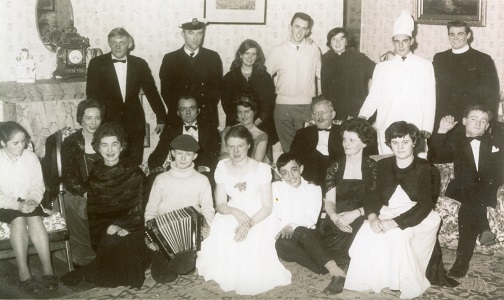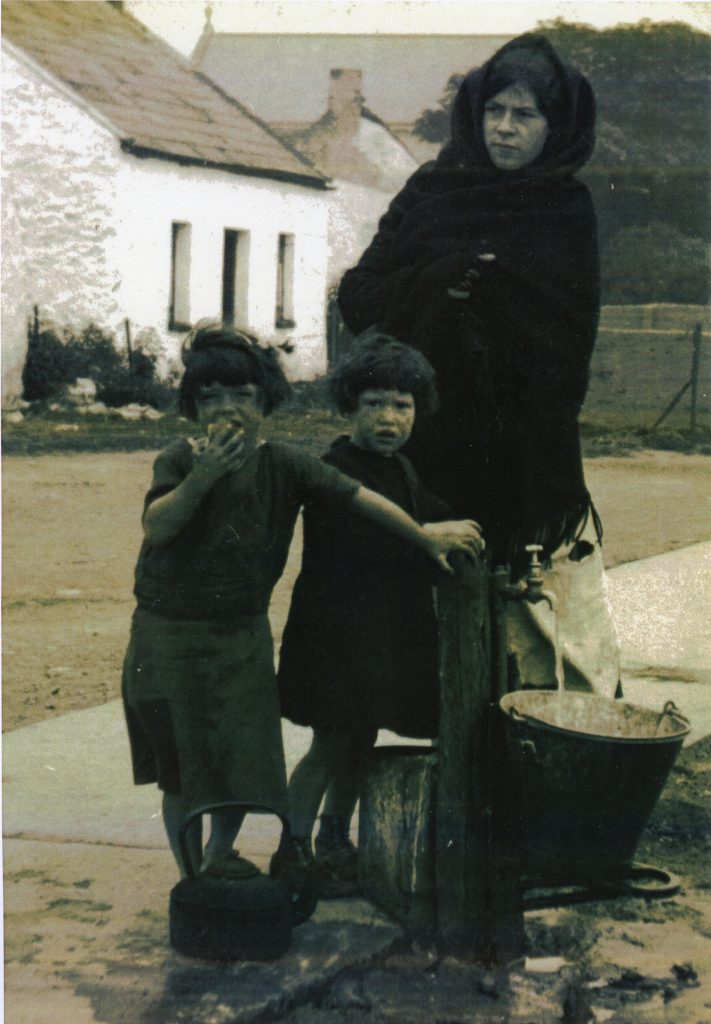Old Galway
Old Devon Park

The area we know today as Devon Park was originally part of the O’Hara Estate which was the land around Lenaboy Castle (now St. Anne’s on Taylors Hill). The main gates to this estate were, and are, next door to the Warwick Hotel. Part of the estate wall ran along the main Salthill Road.
Devon Park as we began when Bertie Simmons broke through part of that wall and built two houses, one on the corner of the main road that became Mitchell’s (where the fish shop is today) and one behind it where the Hartigan family lived. There was a small dirt lane running past these houses and then the Gleasons who were in the construction business moved in and built what was known as ‘The Gleason Estate’ ...the crescent of houses running up the hill to Lenaboy. Then the Corporation built Devon Park, two wings of council houses running parallel to the main Salthill Road. These houses are described today as ‘Old Devon Park’.
THE D & I DRAMATIC SOCIETY

by Tom Kenny
The Dominican and Ignatian Dramatic Society (known as the D. & I.) was set up by Fr. Peadar Feeney S.J. in the late 1950’s. Most of the members were past pupils of St. Ignatius College or The Dominican Convent Taylors Hill. They staged a play every year for several years with any profits accruing going to the two school funds.
Fr. Feeney placed a heavier emphasis on elocution rather than on acting. The cast rehearsed in the Santa Maria Hotel and most of the productions were staged in the Rosary Hall and were reasonably successful, plays such as The Barretts of Wimpole Street, Macbeth, Murder in the Cathedral, Rebecca, The Admirable Crichton, A Man for All Seasons etc.
The Dominican and Ignatian Dramatic Society

The Dominican and Ignatian Dramatic Society (known as the D. & I.) was set up by Fr. Peadar Feeney S.J. in the late 1950’s. Most of the members were past pupils of St. Ignatius College or The Dominican Convent Taylors Hill. They staged a play every year for several years with any profits accruing going to the two school funds.
Fr. Feeney placed a heavier emphasis on elocution rather than on acting. The cast rehearsed in the Santa Maria Hotel and most of the productions were staged in the Rosary Hall and were reasonably successful, plays such as The Barretts of Wimpole Street, Macbeth, Murder in the Cathedral, Rebecca, The Admirable Crichton, A Man for All Seasons etc.
Claregalway Heroes

In the years following the establishment of the Defence Forces, various classes of Army Reserves were experimented with between 1927 and 1939. In May 1927, a Class A Reserve was formed consisting of NCO’s and men transferred to the Reserve. In January, 1928, a Class B Reserve was set up with the object of building up the infantry arm of the Defence Forces. One joined voluntarily, but in doing so, committed to three months initial training and one month’s annual training thereafter. This group had practically ceased to exist by 1934.
THE CHURCH OF ST. JAMES, BARNA

by Tom Kenny
The first church in the Barna area that we know of was a small stone building with a thatched roof on the right of the road down to Silver Strand, just opposite the entrance to Tobar Éanna. You can still see some of the remains there. It was in use until December 1839. On June 4th, 200 adults were confirmed by Bishop Browne there.
The church in our photograph was named after St. James and was built in 1830’s on the main Barna Road. The first Mass there was celebrated on January 5th, 1840. It was a T-shaped structure, rather than cruciform, with a small sacristy attached to the top of the T. It was easier to construct and the Sacristy was placed behind the Sanctuary. It was typical of churches built after the Catholic Emancipation and it was paid for and built by the local Landlords, the Lynch family from Barna House. There was a gallery level in the east end of the nave which was reached by a timber stairs. This and the entrance porch and floor were additions to the original basic church. In a number of similar churches there was a room either over or under the Sacristy where the priest actually lived.
The Church of St James, Barna
The first church in the Barna area that we know of was a small stone building with a thatched roof on the right of the road down to Silver Strand, just opposite the entrance to Tobar Éanna. You can still see some of the remains there. It was in use until December 1839. On June 4th, 200 adults were confirmed by Bishop Browne there.
The Galway Gas Company

The Galway Board of the Town Commissioners was established in the early 1830’s and one of their first objectives was the provision of gas lighting in the city. In December 1836, they invited a Mr. Lyddle from Glasgow to do a survey of the town and he recommended the establishment of a Galway Gas Company. His advice was taken. Shares were snapped up, an agreement was reached between the company & the Town Commission and the Rev. D’Arcy was appointed company secretary.
Hardiman's Description of the Claddagh

“The only occupation is fishing; they never trouble themselves with tillage; a milch cow and a potatoe garden are rare among them ------, then on shore they are principally employed in attending to, and repairing their boats, sails, rigging, cordage etc .., and in making, drying or repairing their nets and spillets, in which latter employment they are generally assisted by the women who spin hemp and yarn for the nets...
.png)
